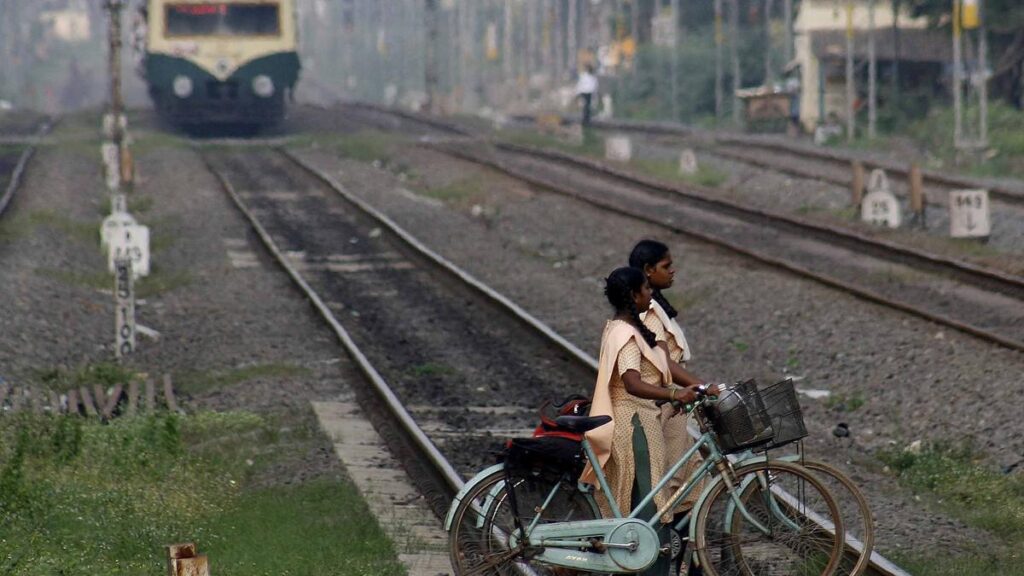Statistics has it that nearly two lives are lost every day on the railway tracks of the Chennai division of Southern Railway. As per data collected by the Railway Protection Force, in the last five months, 275 people were killed and 24 sustained injuries while crossing railway tracks in the Chennai division.
In 2024, 712 people died on the railway tracks and 77 sustained injuries; and in 2023, 669 people died and 63 suffered injuries.
Trespassing, falling from a crowded train and talking on phone while crossing tracks are main reasons for loss of lives in the railway network covering Chennai, Kancheepuram, Tiruvallur, Chengalpattu, parts of Vellore and some areas of Andhra Pradesh.
Southern Railway adopts a three-pronged approach to changing this deadly behaviour: create awareness, register cases under Section 147 of Indian Railways Act as trespassing is punishable with a fine of ₹1,000 or six months of jail or both and close vulnerable points on the tracks.
On June 19, the staff and officers from Villivakkam check post conducted an awareness session for students of Sri Kanaka Durga Telugu Higher Secondary School. Footboard travelling, skating on train platforms, trespassing, taking selfies and videos on the footboard, pelting stones on the train were among the topics covered.

Students of Sri Kanaka Durga Telugu Higher Secondary School in Villivakkam take the safety pledge during an awareness session by RPF
B. Ramakrishna, senior divisional security commissioner, RPF, says such awareness programmes run through the year. “In fact, we are increasingly reaching out to younger children in schools as they get the message faster and would also take it home to their parents,” says Ramakrishna.
While the Southern Railway has been replacing level crossing gates with rail overbridges (ROB) or subways to prevent commuters from crossing the tracks, jaywalking along unauthorised points along the tracks make it a bigger challenge to check this offence.
In suburban areas such as Korrukpet, Ennore and Basin Bridge, fences are erected so that people cannot get on to the tracks.
“Fencing is the most effective measure,” he says.
According to an official from the Safety Department, 10-15 railway level crossings are closed every year.
“Unmanned level crossings have been completely eliminated. Currently we have 153 LC gates across Chennai division, and all these are interlocked gates that provide more safety,” says the official.
Vandhe Bharat trains run at a speed of 130 km/hr, so there must not be an LC gate or cattle crossing over the tracks.
On Chennai to Arakonam section, more LC gates are waiting to be closed as Southern Railway is waiting for funds.
When the number of vehicles/ units taking a gate crosses 1 lakh, the gate must be replaced with a ROB or a subway. That is the thumb rule, he says.
Do fines act as a deterrent? From January 2025 to the second week of June, RPF had booked 1,650 people and collected a fine amount of ₹7 lakh.
Officials say these measures are helpful to some extent. Are youngsters fined? They are usually let off with a warning but repeat offenders are booked. “Youngsters performing stunts in local trains was a serious concern and we would call their parents, show the videos of their antics and take a written undertaking that if the child indulges in such activities a criminal case will be filed. This has worked to a great extent,” says senior divisional security commissioner.
He says institutions and the larger society must also play a role in sensitising people about the danger of jaywalking on the tracks. “Talking on the phone and crossing are a strict no. Use foot overbridges and subways where they are provided. Do not take reels on trains. After all, life is precious,” says Ramakrishna.
A case study from Western Railway: Using behavioural science to prevent trespassing
A behavioural science approach was adopted to check the increasing number of deaths on Mumbai’s suburban railway network many years ago.
Indian Railway approached Final Mile, a behavioural science and design consultancy firm, that studied data and investigated the psychology of risk perception. The simple, science-informed, and cost-effective design interventions brought down the number of deaths on tracks.
Their research found that “the current system of warning signs, using text and stick-figure illustrations, was ineffective. Second, the train drivers’ practice of sounding the horn was not successful in alerting people: either it was too familiar to catch people’s attention, or they honked too late to make a difference: once people were on the track and heard the horn, they decided to run for it rather than to turn back – but they could not outrun the train. A third, related observation was that people crossed even when they could clearly see the oncoming train,” says a note on www.thefinalmile.com.
They designed solutions that worked at a “nonconscious level” and even recommended changing the way drivers used their horns to warn people. To tackle the problem of incorrect perception of the train’s speed, railway ties were painted yellow at regular intervals on either side of trespassing points. The bright stripes attract attention, and as they disappear under a moving train, the brain quickly and unconsciously recalibrates its estimate of the train’s speed, says the note. Their first pilot reduced fatalities by 75% in a year and this was scaled up to multiple locations around the suburban railway network. In 2019, a 5 km stretch of the Central Line that had seen 88 deaths experienced a 44% decline in fatalities.
Published – June 22, 2025 07:19 pm IST
Source:https://www.thehindu.com/news/cities/chennai/trespassing-tracks-a-dangerous-trend/article69724740.ece

